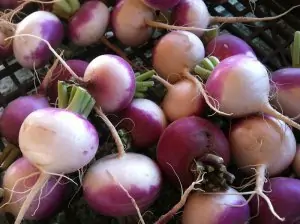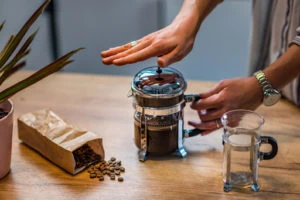Today we’re going underground for some fresh root vegetables—turnips! What are turnips? What do they taste like? Are they like rutabagas or radishes?
Root vegetables are staples of any kitchen, but turnips are special. You can make all kinds of delicious soups or substitute other more common vegetables, like carrots, with turnips.
Turnips may look similar to radishes, but there are differences in flavor and texture! Let’s dig right in as I explain what you need to know about the turnip and its counterparts.
Rutabaga versus Turnip
I should explain the key difference between the root vegetables. Turnips are light-skinned with purple hues throughout. The interior flesh is white, and they have a taproot, the long “tail” at the bottom of the vegetable, which is generally trimmed off before cooking. Turnips also have green leaves at the end of their stems.
Rutabagas are mostly yellow or brownish. Rutabagas also have grassy leaves at the end of their stems. Rutabagas are also bigger than turnips because turnips are harvested when they are small and tender. If turnips are allowed to grow any larger, their textured skin becomes harder and less edible. I certainly don’t recommend eating turnips that are large and tough!
In terms of taste, turnips taste like a cross between cabbages and radishes. They are bitter when raw, but have a distinctive but mild spicy tang when cooked.
In comparison, rutabagas are slightly sweeter. Both have an earthy rustic flavor, but the rutabaga is a bit stronger than the turnip.
I use both turnips and rutabagas for recipes like roasted vegetables or use them as ingredients for soup. Next time you try an old recipe with potatoes, try a turnip or rutabaga instead.
I especially like mashed turnips with butter, salt, and pepper with my Thanksgiving dinner instead of the traditional mashed potatoes!
Give turnips a chance, and you might be impressed with their flavor profile.
Radish versus Turnip
Radishes are, obviously, a type of vegetable. There are many different kinds of radishes, all with their own unique colors and sizes.
The most common radishes are the small red ones with green leaves. They’re probably the ones you’re used to seeing in the produce section or in your mixed green salad.
However, there is another popular radish called a Daikon radish. From Japan, it is bigger than our red radishes, with a white-colored flesh. The key difference between them is American radishes don’t have as long of a harvest season.
Turnips and radishes do taste similar, but radishes are definitely spicier, with a big zesty hint of pepper: radishes definitely have a bit of a kick!
If you want a less spicy vegetable with your meal, go with the turnip. One key difference between radishes and turnips is that radishes taste better when raw, while turnips taste better when cooked. They both have good nutritional value whether raw or cooked, so you may want to try them both ways.
Fun fact: the green leaves of both these vegetables are edible! However, radish leaves have a fuzzy texture that might be off-putting to some people. If you want to try eating radish leaves, I suggest you cook them in boiling water to soften their fuzzy texture and then seasoning them as you would collard greens or spinach.
Another great way to use turnip or radish leaves: use them in a green recipe like pesto! Wash them carefully and use a food processor to blend them into your mix.
Do You Peel Turnips?
Of course you can peel turnips, just as you might peel any vegetable! Make sure to peel them right before you start cooking with them.
Turnips are starchy vegetables, so they get darker as the skin is removed. Cut off the top and bottom of the turnip, then peel them. Be careful as you cut, and don’t let your thumb get in the way. Maintain a firm grip as you hold the turnip.
A good proper cutting tool to get the job done helps peel turnips and other vegetables quickly and safely. I like the OXO Swivel Peeler from Good Grips! It has swiveling twin blades – they provide flexibility when you peel. The handle is comfortable to hold and has a nice grip. It’s also dishwasher safe!
If you don’t want to peel turnips manually, I highly recommend you try the Starfrit Electric Rotato Peeler from Amazon. The machine peels the skin off root vegetables without waste, and it’s great for peeling turnips. It has built-in storage with a non-slip base, which is quite convenient.
Can You Freeze Turnips?
If you have leftover turnips or even fresh ones you’re not going to use immediately, you need to store them properly.
If you don’t want to actually freeze turnips, but you absolutely do want to keep them at a very cold temperature in a cold storage area, anywhere within the 33°-40° Fahrenheit range.
Wrap the turnips with a moist towel and place them in your refrigerator’s vegetable drawer. Properly stored this way, turnips will last for about four to five months. You do want to check in on them every now and then to make sure the turnips aren’t spoiling.
You can freeze turnips, but it’s a bit more difficult than just sticking them in the deep freeze.
To freeze turnips: fill a bowl with water and ice. Boil a stockpot full of water and add a pound of turnips. After they have boiled for two minutes, drain the turnips and then submerge them in the ice water. After they cool (take them out while the water is still very cold), drain them again. Place the turnips inside a plastic storage bag and store them in the freezer. They will last eight to ten months, taking you through the winter months.
Turnip Substitutes
Perhaps you have a recipe that calls for turnips, but you don’t like or don’t have turnips on hand. Don’t worry; there are great substitutes for turnips! You want to choose root vegetables with the rustic taste turnips have.
If your recipe calls for turnips, you can always try parsnips instead. Similar to turnips, parsnips have a sweet earthy flavor. They even look similar to each other.
If you like the taste of rutabagas, you can also substitute them for turnips, as they have flavor profiles that are alike and also have slightly similar textures. Rutabagas add a peppery taste to your recipes, so try switching those for the turnips if you are in the mood.
Potatoes and carrots, especially sweet ones, are good, safe choices to use as substitutes for turnips. I would go with a mix of both, personally. Keep in mind, both potatoes and carrots cook more quickly than regular turnips.
Give all these other root vegetables a trial run to see if you like the flavors. There are several vegetarian recipes you can make with these substitutes alone. There’s a great root vegetable soup from New York Times Cooking that I love to make on cold winter days. I enjoy mixing it up every now and then with these ingredients when my recipes call for turnips.
Are Turnips Bitter?
Although turnips generally have a mild flavor, they sometimes can taste bitter.
Why does this happen? Plants can suffer from the effects of stress, which result in them secreting chemicals that cause that slightly bitter taste. Causes of plant stress include bad weather conditions and changes in growth rates.
I would avoid any vegetables with bad-looking flesh. Fresh turnips look clean with bright colors. The green leaves should also be crisp and firm. Believe me, fresh turnips tend not to taste bitter.
Watch out for turnips that seem “off” the next time you buy a turnip. Keep in mind its appearance. If it looks rotten in certain areas, stay away! You can also smell the turnip. If it has an off-putting odor, then it might be spoiled.
The Lowdown about Turnips
Turnips have so much versatility. I definitely suggest making them a staple in your kitchen. They’re an ingredient you can do so much with, and they are quite nutritious.
Turnips work well as a side for your dinners, especially with chicken, turkey, and beef. They are healthy for you and your family and can last a long time in your refrigerator (and even longer in the freezer) if you properly store them.
Try mashed turnips with butter or gravy instead of mashed potatoes with your next turkey dinner, or substitute turnips for carrots the next time you make a good roast or beef stew.
If you like turnips, you might also like rutabagas and radishes. If you like root vegetables with a bit of a kick, turnips are exactly what you need to look for on your next shopping trip.
Frequently Asked Questions:
How Do You Remove Bitterness From Turnips?
Plant stress is a major cause of bitterness. If you’ve bought some turnips that are slightly bitter, all is not lost–you can make those turnips taste fresh.
Trim off the root of the turnips. Use running water to wash the turnips in a bowl or strainer. Peel the turnips, then cut them up into little cubes. Put the turnips in a pot with boiling water, then reduce the heat to medium. Then, add the secret ingredient: a potato. Boil the potato right with the turnips. The potato will absorb the bitterness from the turnips. Now you will have turnips that taste fresh.
How Do You Cook Turnips?
You can bake them, boil them, and steam them!
As I said before, boiling takes away the bitterness of turnips if you add a potato in the water.
Speaking of potatoes: I often cook turnips the same way I would potatoes. Turnips are perfect for soups given their earthy flavor. When you cook them, try adding salt, butter, or lemon juice for extra explosive flavors.
I also mash turnips as I would potatoes. Remember, these root vegetables are quite similar. They are good substitutes for each other.
Can You Eat Raw Turnips?
Sure! The best part about turnips is the different ways to try them. You can eat turnips however you like.
Turnips contain important vitamins and minerals while also being a good source of fiber. Make sure the turnip is clean first! Run it underwater before you take a bite. When you eat it raw, however, it can have a sharp aftertaste, so be prepared.
I enjoy slices of raw turnip with a savory dip like hummus to add extra flavor. It has a nice crunchy bite when it’s raw. I also like adding sliced turnip on my green mixed salads and also sometimes grate them as a topping for other foods.
I suggest slicing or cubing your turnips before eating them raw Cutting raw turnips is simple. Just cut them into small cubes or slices after you get rid of the stems. Make sure to peel the turnips first!
What Else Can You Do With Turnips?
Enjoy them any way you like. Try it as a side meal or switch up your greens with this substitute. Whether turnips are boiled, baked, or steamed, they give you plenty of flavors. I recommend pairing turnips with other rustic vegetables. Try turnips with mushrooms in a mashed potato recipe! You can roast turnips by adding some olive oil and a little bit of lemon. Use baked turnips and carrots for root vegetable goodness.
Additional Resources:
New York Times Cooking: Root Vegetable Soup
MedicalNewsToday: The Health Benefits of Turnips








Rhonda grew up with parents who gardened, hunted, fished, canned, and preserved food. Her mother was a professional cook and Rhonda credits her teaching everything from how to make homemade biscuits and gravy to what kind of meals to serve for different occasions. In the kitchen, Rhonda uses a mix of old-fashioned country cooking and up-to-date fads in the kitchen, often experimenting with replacing higher-calorie or fat ingredients with healthier options that still retain the delicious flavors of the originals.